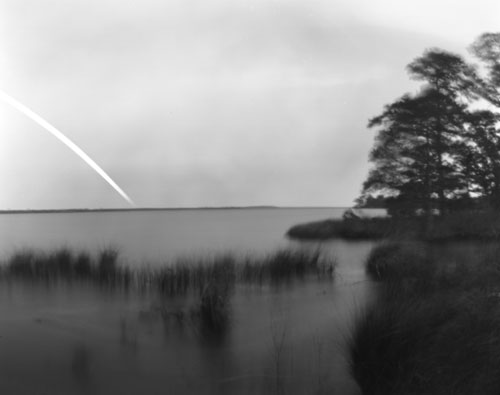It was windy and cloudy with occasional sprinkles on Thursday night. The forecast was for more of the same until the early morning, then thunderstorms between 6 am and noon. All in all, not an especially promising night for a moon shot. But, I’ve wanted to branch out into pinhole lightning images, so I decided to plant a camera anyway.
This evening was two days before the full moon, so my shot was going to face west to catch the setting moon. The moonrise was coming up before the sunset, so I couldn’t shoot the moonrise (at least in the approach I take). I returned to Mashoes, on the mainland for the scene. I really like this location, looking out across East Lake. I set out one tin can camera and waited for the middle of civil twilight to open the aperture. The location was a short distance down a narrow path through the grasses, so I was a little surprised with a Fish and Wildlife agent appeared. He asked if I was fishing. I thought about telling him about how I set out the “moon pots” to catch images of the moon, sort of like setting out “crab pots” to catch crabs. So I hesitated a second before replying “not exactly”. Then I changed my mind, realizing he was probably there to catch some illegal fishing activity or something to do with homeland security. So, I told him what I was doing. He seemed real interested and we talked about it for a while. He asked if I exhibited anywhere and I told him about Gallery 101 where I just added some moon photos. Then he wished me well and headed back down the path. A real nice guy. I was glad he had stopped by, as it was a little weird out there – a steady cool wind, the light growing dimmer, and I was checking all around me for water moccasins.
The sky was interesting as it often is here. Dark grey low clouds flew by, thinning out to expose light blue sky and yellow billowing clouds reflecting rays of the sun now setting far to the west. I hadn’t brought but one camera with one sheet of b&w film, or else I might have tried to capture the atmosphere in that sky. But, it would be all grey clouds in just a few minutes anyway. I opened up the camera and headed home.
I reluctantly got up around 5:15 the next morning and drove over to retrieve my moon pot. It’s about a 15 minute drive, and I saw maybe 2 cars. I couldn’t believe how clear the sky was. A weather forecast on the Outer Banks is really just a crapshoot. The only clouds were over the ocean, the opposite direction from my scene. I closed up the camera and headed home.
I don’t mean to bore anyone to death who is still reading this, but I had an invigorating morning and still have some wind left in me. I developed the film, and the negative (1) came out, and (2) looked like a decent exposure. Then I added mixed up some paper developer and added water to my fixer and developed a paper negative from a couple of days earlier. That one looked OK also. That was just an experiment with a long exposure using a zone plate. While I was developing the film in trays, and in the dark, I came up with an idea for a special camera for a project I’m working on. As soon as I finished developing and cleaned up the darkroom, I sketched out the camera plans. I was on a roll! I was so full of energy, after having gotten up at 5:15. But then I realized I had to start my day job, and that can bring me down fast. So I took a shower and then checked in at the pinholeday.org website to see if there were any new postings from pinhole day to review. There were a couple and I reviewed and approved them. But, I was sure disappointed that I had to start work. I was ready to build that camera, take some more zone plate test shots, anything but work. So it goes…
Photo

Sunset, Moonset, East Lake, 2006.5.11/12
Timeline
Manteo, Dare County, North Carolina (longitude W75.7, latitude N35.9):
May 11, 2006
- 6:41 p.m. – Moonrise
- 7:58 p.m. – Sunset
- 8:10 p.m. – Open aperture
- 8:26 p.m. – Civil twilight ends
May 12, 2006
- 4:50 a.m. – Moonset
- 5:29 a.m. – Civil twilight begins
- 5:53 a.m. – Close aperture
- 6:18 a.m. – Sunrise
Phase of the Moon on 11 May: waxing gibbous with 97% of the Moon’s visible disk illuminated.